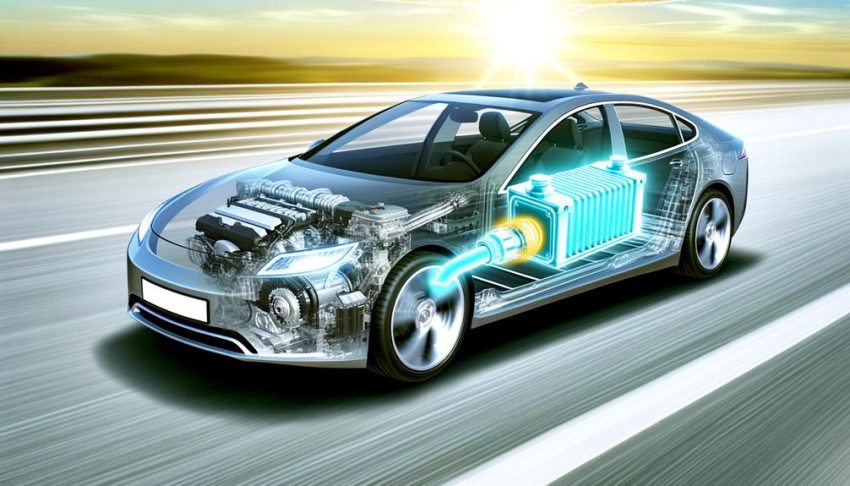So, you're curious about what a mild hybrid car is and how it works? Fundamentally, it's a vehicle that combines a small electric motor and a low-output battery with a traditional internal combustion engine (ICE). Unlike full hybrids, mild hybrids can't run solely on electric power but use the motor to assist the engine during acceleration, which boosts performance and fuel efficiency. This setup offers about 15% better fuel economy and lower CO2 emissions. But what makes mild hybrids particularly appealing for today's drivers? There's more to their appeal than just environmental benefits.
Contents
Definition and Functionality
Understanding the definition and functionality of mild hybrid cars involves exploring their unique integration of electric and internal combustion components. These vehicles feature a small electric motor and a low-output battery, typically operating on a 48-volt system, designed to complement the internal combustion engine (ICE) rather than replace it.
Mild hybrid cars can't drive solely on electric power. Instead, they use the electric motor to assist the ICE during acceleration, providing additional torque and improving overall performance. This assistance is particularly beneficial during stop-and-go city driving where the electric motor can reduce the load on the ICE, thereby enhancing fuel efficiency. The electric motor is also part of a regenerative braking system, which captures kinetic energy during deceleration and stores it in the battery for later use. This recovered energy helps power the starter motor and other auxiliary systems, thereby reducing fuel consumption and emissions.
The system includes a generator-motor unit that integrates the starter motor and alternator functions into one component. This unit provides electrical support to the ICE, ensuring smoother and quicker start-stop changes, which further contributes to fuel efficiency gains of about 15% over conventional vehicles. Unlike full hybrids, which can operate independently on electric power at low speeds, mild hybrids always rely on the ICE for propulsion, making them simpler and less costly to implement.
While the electric motor and battery in mild hybrid cars are modest in size, their strategic use in enhancing the ICE's efficiency and lowering emissions makes them a practical choice for those seeking improved performance and fuel savings without the complexity of full hybrid systems.
Environmental Impact
Evaluating the environmental impact of mild hybrid cars reveals their significant potential to mitigate CO2 emissions. By integrating hybrid systems with internal combustion engines (ICE), mild hybrids achieve a reduction in CO2 emissions by 15%-25%. This reduction contributes to climate protection amid the growing trend of e-mobility. Mild hybrids employ an electric drive that assists the ICE, leading to improved fuel consumption and overall efficiency. This enhancement directly translates to lower emissions from combustion engines, making these vehicles a vital part of the strategy to combat climate change.
The adoption of 48V mild hybrid technology in new vehicles can result in substantial environmental benefits. It's projected that by 2040, this technology could save at least 2 billion metric tons of CO2 globally. Given that over 1 billion ICE vehicles are expected to be on the road by 2040, the shift to mild hybrids is essential to address the potential surge in CO2 emissions. Mild hybrids, consequently, play a pivotal role in reducing emissions and aligning with global environmental targets.
Political commitments in regions like Europe and China have set stringent emission regulations, and mild hybrids offer a viable solution that supports these regulations. By improving fuel efficiency and reducing emissions, mild hybrids help these regions meet their ambitious environmental goals. The integration of mild hybrid systems enhances the overall efficiency of combustion engines, making them a more sustainable option in the automotive industry.
Benefits for Drivers

While mild hybrid cars contribute considerably to environmental sustainability, they also offer numerous benefits directly to drivers. The mild hybrid system leverages a 48V electrical system to enhance vehicle performance. By using an electric motor to assist the internal combustion engine (ICE), particularly during acceleration, you'll experience smoother starts and reduced engine noise and vibrations. This seamless integration of the electric motor provides a more refined driving experience.
One of the primary advantages is the improved fuel economy. The mild hybrid system allows for coasting with the engine off at high speeds, conserving fuel and thereby reducing overall consumption. Over the vehicle's lifetime, you could potentially save over 1,500 liters of fuel. This not only lowers your fuel expenses but also contributes to reducing CO2 emissions by around 4 tons, making your driving more eco-friendly.
Additionally, the energy recovery capability of mild hybrids is particularly beneficial. The system recovers braking energy and stores it in the battery, which can then be used to support the ICE during acceleration. This process enhances the vehicle's efficiency and performance without the need for frequent charging, making it an ideal choice for long-distance drivers. Unlike plug-in hybrids, you won't need to rely on charging infrastructure, offering a practical and convenient solution.
Technical Integration
Integrating mild hybrid technology into vehicle powertrains involves sophisticated engineering that maximizes efficiency with minimal disruption to existing systems. A mild hybrid electric vehicle seamlessly incorporates a 48V electrical system, which powers key components like regenerative braking and assists the internal combustion engine during acceleration. This integration achieves significant fuel savings, enhancing performance without extensive modifications.
In terms of technical integration, the P0 topology is particularly remarkable. Utilizing belt integration, the P0 topology minimizes modifications to existing powertrain architectures while delivering significant fuel savings. Its simplicity and cost-effectiveness make it a popular choice for implementing mild hybrid systems. By placing the electric motor between the engine and the transmission, the P0 topology reduces the need for extensive reengineering, lowering mechanical complexities and associated costs.
However, other topologies such as P2, P3, and P4 offer varying levels of mechanical complexity and performance benefits. The P4 topology, for instance, provides the highest potential fuel savings—up to 25%—by minimizing frictional losses. This topology positions the electric motor at the rear axle, decoupling it from the internal combustion engine and further optimizing efficiency.
The 48V electrical system is critical for enabling these advancements. It supports regenerative braking, which captures and stores energy that would otherwise be lost, and provides additional power during acceleration. This system guarantees that the mild hybrid electric vehicle can deliver enhanced performance and fuel efficiency with minimal changes to the existing infrastructure.
Market Adoption

The burgeoning adoption of mild hybrid technology is reshaping the automotive landscape, with over 4.5 million vehicles already equipped with 48V systems. This trend is accelerating, with projections indicating that production will exceed 10 million by 2025. Major automotive manufacturers like BMW, Land Rover, and Mercedes-Benz have integrated mild hybrid systems across a broad spectrum of their models, signaling a significant alteration in the industry.
One key driver behind this market adoption is the improvement in fuel economy that mild hybrid vehicles offer. Unlike full hybrids, mild hybrids don't rely on electric power alone; instead, they use a combination of a traditional internal combustion engine and a small electric motor. This setup enhances fuel efficiency by providing additional power during acceleration and enabling regenerative braking, which charges the battery. Consequently, these vehicles meet stringent CO2 emission regulations more easily, making them attractive to manufacturers aiming to reduce their carbon footprint.
Consumer interest in mild hybrid vehicles is also on the rise. As people become more eco-conscious, they seek vehicles that offer improved performance and fuel economy without the need for charging infrastructure. Mild hybrids fill this niche perfectly by delivering the benefits of hybrid technology while maintaining the simplicity of traditional combustion engines.
Moreover, mild hybrids are seen as a stepping stone technology toward full electrification. They strike a balance between cost-effectiveness and technological advancement, providing a bridge for consumers and manufacturers alike. This positions mild hybrids as a fundamental component in the broader shift toward sustainable automotive solutions.
Frequently Asked Questions
What Is the Difference Between a Hybrid and a Mild Hybrid?
A hybrid boasts better fuel efficiency and emissions reduction than a mild hybrid due to larger battery size and electric assist. Mild hybrid technology offers energy recovery and slight fuel benefits but is cheaper, impacting driving experience and market trends.
What Is the Point of a Mild Hybrid Car?
You'd appreciate a mild hybrid for its improved fuel efficiency and lower maintenance costs. The advanced battery system enhances your driving experience, reduces environmental impact, and aligns with market trends and consumer preferences for cost-effective, efficient technology advancements.
Is It Worth Buying a Mild Hybrid Car?
Considering fuel efficiency, cost savings, environmental impact, and battery technology, mild hybrids offer a smooth driving experience, lower maintenance costs, and strong resale value. With market trends and government incentives, they're a smart choice for informed consumers.
What Is the Difference Between Mild Hybrid and True Hybrid?
You'll find that mild hybrid technology offers energy recovery and improved fuel efficiency with a smaller battery capacity. True hybrids provide better vehicle performance, greater environmental impact, and higher fuel savings, but mild hybrids bring significant cost savings and align with market trends.
Conclusion
In conclusion, a mild hybrid car seamlessly integrates a 48-volt electric motor and a low-output battery with a traditional internal combustion engine, boosting performance and fuel efficiency by roughly 15%. You'll find that regenerative braking, reduced CO2 emissions, and enhanced acceleration make mild hybrids an eco-friendly choice. While they can't run solely on electric power, their technical advantages and growing market adoption underscore their viability as a smart, environmentally responsible option for modern drivers.
